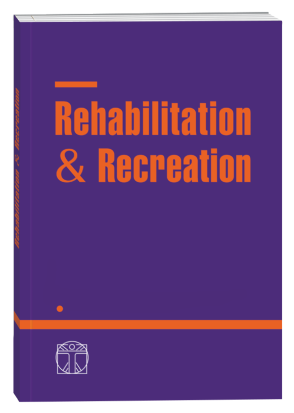INTRODUCTION OF PHYSICAL THERAPY AND CHANGE OF DIET IN AN OBESE PATIENT WITH HYPERTENSION – A CASE STUDY
DOI:
https://doi.org/10.32782/2522-1795.2024.18.3Keywords:
hypertension, obesity, physical therapy, health, DASH dietAbstract
Arterial hypertension is a lifestyle disease. According to the World Health Organization, it is the first cause of premature death. In patients with SCT of 180 mm Hg and/or RCT of 110 mm Hg, hypertension can be diagnosed already during the first visit. Some risk factors that contribute to hypertension can actually be influenced. One of these factors is obesity, and the consequence of obesity is hypertension. It is expected that by 2025, hypertension will affect 1.5 billion people worldwide. Non-pharmacological treatment, including lifestyle modification, plays a very important role in the treatment of hypertension. Some risk factors that contribute to the development of hypertension can actually be controlled. One of these factors is obesity, and the consequence of obesity is hypertension. It is expected that 1.5 billion people worldwide will suffer from hypertension by 2025. Non-pharmacological treatment plays a very important role in the treatment of hypertension, including lifestyle changes, especially homework, physiotherapy and diet. Clinical trials have shown that the antihypertensive effect of targeted lifestyle changes may be equivalent to the effect obtained with a single antihypertensive drug. The study involved a patient who had been suffering from hypertension for 16 years and was also struggling with obesity. The study lasted 3 months and included lifestyle modification by introducing physical activity and changing the diet. In order to simplify the diagnosis and facilitate treatment decisions, it was established what blood pressure values are considered normal and when they are considered abnormal. Arterial hypertension is diagnosed when the mean blood pressure values (calculated from at least two measurements taken during at least two different visits) are equal to or higher than 140 mm Hg for SCT (systolic blood pressure and/or 90 mm Hg for RCT (diastolic blood pressure). Arterial hypertension. The Framingham study proved that in 78% of men and 65% of women, the development of arterial hypertension is directly related to obesity.
References
American College of Sports Medicine Position Stand: Exercise and physical activity for older adults. Medicine & Science in Sports & Exercise, 2009. 49–67.
Andrieieva, O., Maltsev, D., Kashuba, V., Dutchak, M., Ratnikov, D., Grygus, I., Byshevets, N., Horodinska, I. (2022). Relationship Between Quality of Life and Level of Physical Activity and Family Well-Being. Physical Education Theory and Methodology. 22(4):569–575.
Czarnecki D., Skalski D.W., Kowalski D., Vynogradskyi B., Grygus I. (2022). Aktywność fizyczna seniorów warunkiem zdrowia i dobrej jakości życia. Rehabilitation & recreation. 12:105–112. https://doi.org/10.32782/2522-1795.2022.12.15.
Czarnecki, D., Skalski, D.W., Grygus, I.M. (2022). Free time of elderly people in terms of physical activity. Quality in Sport. 8(4):33–38. http://dx.doi.org/10.12775/QS.2022.08.04.003.
Czarnecki, D., Skalski, D.W., Grygus, I.M. (2023). Health effects of physical activity of the elderly. Scientific monograph. / Red. Grygus I.M., Kashuba V.O., Mahlovanyi A.V., Skalski D.W. Riga, Latvia: “Baltija Publishing”, 347–368.
Czyżewska, E., Górski, J., Nazar, K. (2001). Układ krążenia. / Górski J. (red.). Fizjologiczne podstawy wysiłku fizycznego. Wydawnictwo Lekarskie PZWL, Warszawa. 12–16.
Dylewicz, P., Przywarsk,a I. (2011). Fizjoterapia w rehabilitacji kardiologicznej. / Kasprzak W. (red.). Fizjoterapia kliniczna. Wydawnictwo Lekarskie PZWL, Warszawa, 145–176.
Jegier, A. (2005). Aktywność ruchowa w promocji zdrowia oraz zapobieganiu chorobom przewlekłym. / Jegier A., Nazar K., Dziak A. (red.). Medycyna sportowa. PTMS, Warszawa. 45–68.
Jegier, A. (2012). Regularna aktywność fizyczna jako ważny element w promocji zdrowia i prewencji chorób przewlekłych. / Jegier A., Krawczyk J. (red.). Wybrane zagadnienia medycyny sportowej. Wydawnictwo Lekarskie PZWL, Warszawa. 134–156.
Krawczyk, J. (2012). Wybrane zagadnienia medycyny sportowej. Wydawnictwo Lekarskie PZWL, Warszawa. 78–92.
Mahlovanyy, A., Kunynets, O., Grygus, I., Ivanochko, O. (2023). The influence of dosed physical exercise on indicators of the cardiovascular system of persons who have lost limbs. Rehabilitation & recreation. 14:63–70. https://doi.org/10.32782/2522-1795.2023.14.7
Nesterchuk, N.O., Kulaj, O., Grygus, I., Skalski, D. (2021). Fitness and physical therapy of obesity patients. Zarzadzanie kultura fizyczna zdrowiem i bezpieczeństwem. Starogard Gdański, 56–64.
Ostrowska, L. (2018). Diagnostyka laboratoryjna w dietetyce.
Przybylski, J., Czarkowska-Pączek, B. (2006). Czynnościowa adaptacja układu krążenia do wysiłku fizycznego. / Czarkowska-Pączek B. Przybylski J. (red.). Zarys fizjologii wysiłku fizycznego. W.M. Urban & Partner, Wrocław. 56–87.
Wadden, T.A., Webb, V.L., Moran, С.H., Bailer, B.A. (2012). Lifestyle modification for obesity: new developments in diet, physical activity, and behaviortherapy. Circulation. 125:1157–1170.
Więczkowska, H. i wsp. (2011). Nadciśnienie tętnicze – choroba trudna i kosztowna. Forum Zaburzeń Metabolicznych. 2:34–44.
Wysocki, K., Ożdziński, J. (2004). Wpływ aktywności ruchowej i ćwiczeń relaksacyjnych na wspomaganie leczenia farmakologicznego w nadciśnieniu tętniczym. Medicina Sportiva. 45–50.
Downloads
Published
How to Cite
Issue
Section
License

This work is licensed under a Creative Commons Attribution-NonCommercial-NoDerivatives 4.0 International License.












